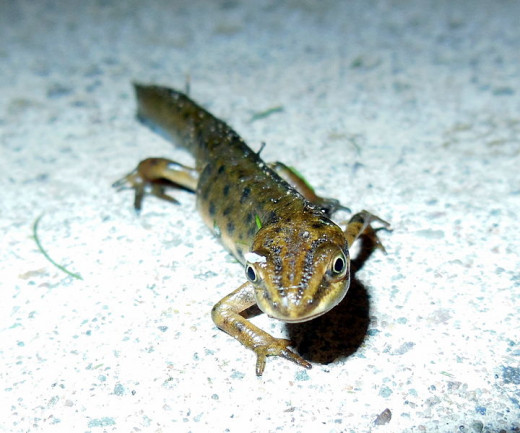A Guide To The Amphibians Of Britain
The Common Frog

Jeremy Fisher- The Frog Immortalised by Beatrix Potter
Common Frog
Open woods and lush pastures are typically the home of the common frog, which likes moist places not too far from water. But frogs are becoming increasingly common in gardens with ponds, and it is not unusual to find a hundred or more using a pond for spawning. As frogs eat insects and small animals such as slugs and snails, they are good friends to the gardener. They like to hide in tall vegetation on summer days, and emerge on warm damp nights to hunt.
In winter, from about mid October, common frogs hibernate in sheltered places on land or in the muddy bottoms of ponds. They emerge to migrate to breeding ponds, often in January in the south west but usually stay in the water until the weather gets warmer, leaving during April to live on land. When the young frogs emerge in June or July, large numbers are killed by predators such as blackbirds. At any age they may fall prey to a host of animals, including crows, herons, ducks, hedgehogs, rats, foxes, grass snakes and cats. Common frogs are now rare in farmland, mainly because of the increase in arable fields being treated with pesticides, and the neglect or filling in of ponds.
The Marsh Frog

Marsh Frog
The largest frog in Europe, the marsh frog was introduced to Britain from Hungary in 1935 by a zoologist, Percy Smith. He released some in his garden at Stone-in-Oxney on the border of Romney Marsh in Kent. The frogs soon spread to the drainage dykes and ditches that criss cross the marsh, and in 1937 they were so numerous that their croaking at night brought complaints from local residents. Although the frogs have spread beyond the marsh to adjoining areas of Kent and Sussex, attempts to introduce them to other parts of Britain have not been very successful.
Marsh frogs like to bask in the sun, but quickly take to the water if disturbed. They feed mostly on land, mainly eating flying insects. At breeding time in late May or early June, the males gather in the water in small groups and croak loudly, fully distending their vocal sacs, as they call to attract females. The spawn is deposited in small clumps among water weeds and the tadpoles are rarely seen. Young frogs emerge from the water in September and October. Romney Marsh has long been used for sheep grazing, but a change to arable farming is altering the dyke system and could affect the marsh frog's survival.
Common Toad

Mr Toad Immortalised In Wind In The Willows
Common Toad
Toad migration in March or early April can be a spectacular affair. Within the space of a few days, hundreds of common toads leave their hibernation places and make for their breeding pond, on their way climbing walls and other obstacles and crossing roads en masse. Many are killed, especially by vehicles, and in some places warning signs are erected on busy roads.
Common toads like to spawn in fairly deep water. Strings of spawn are usually about seven to ten feet long. Eggs develop into tadpoles and then young toads in about ten to sixteen weeks depending on the weather. Young toads leave the water in June or July, with only one in twenty surviving to adulthood. Males are ready to breed at about three years old and females a year later, so males heavily outnumber females at breeding time.
When spawning is over, adults leave the ponds to live alone through the summer. Most of the day is spent under logs, but the toads emerge in the evening to catch insects and other small animals. They sit and wait for prey to come within range of their long tongue, which is rooted at the front of the mouth and can be extended for nearly an inch. In captivity, common toads may live for twenty years, but in the wild not usually more than ten.
Natterjack Toad

Natterjack Toad
The name of the natterjack toad is probably derived from the Anglo Saxon word naeddre, which meant a serpent or crawling creature. The addition of 'jack' may refer to the toad's small size, as it does in jack-snipe, for instance. The natterjack is found only in sandy places, mainly in coastal dunes in East Anglia and north west England, but was once common on southern heath-lands. Now its numbers are declining and it is protected by law.
Natterjack toads dig burrows in soft sand, and often shelter there in a group. They generally emerge to forage at night, feeding on insects and other small animals. Winter is spent buried one to two feet deep in the sand. Spawning begins in April and continues until June or July. During this time the males sit in the water round the edges of the shallow, sandy pools used for breeding and croak loudly. Their night chorus can sometimes be heard more than half a mile away. Many tadpoles die because their pond dries up before they become toadlets. Most toadlets leave the water in June or July.
Although natterjack toads have poisonous skins, some predators, such as gulls and crows, for example, have learned to eat them leaving the skin untouched. In the wild, natterjack toads may live for ten to twelve years.
The Common Newt

Common Newt
Although common newts live in their breeding pools for most of the spring, they spend summer and autumn on land. Most newts also hibernate on land during winter. Open woodland and scrub or lush pasture, with suitable breeding ponds near by, are typical places to find newts, and they are becoming common in gardens. By day they hide under stones or logs or in thick grass. On damp nights they emerge to hunt for slugs, worms and insects, tracking prey by both sight and scent. Newts look something like lizards but have no scales and move very slowly. They never bask in the sun as lizards do.
Early in spring newts move to the water to breed. The eggs are individually wrapped in water plant leaves. Adults return to land in early summer, leaving the tadpoles to develop into fully formed but tiny newts which emerge to live on land at the end of the summer. They stay there until they are two years old, when they then return to the water to breed. Common newts are the most abundant, but palmate newts tend to take over in heathland or uplands.
If they are able to steer clear of predators such as hedgehogs, rats and various species of snake, a common newt can expect to live up to ten years.
© 2014 James Kenny








